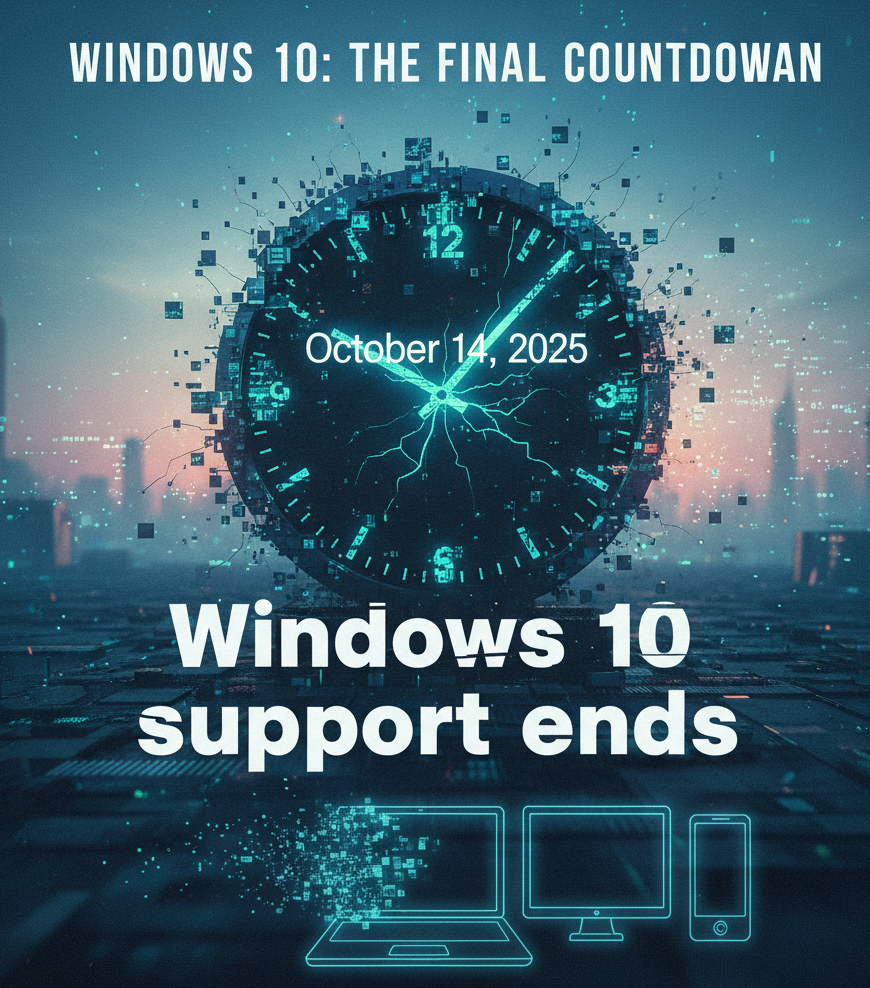Windows 10 Support Ends on October 14, 2025: What Happened and Why It Happened After a full decade of powering millions of computers worldwide, Microsoft is finally ending support for Windows 10. The company has officially announced that October 14, 2025 will be the last day the operating system receives security updates or technical assistance. This marks the end of an era for one of Microsoft’s most popular and long-lasting operating systems. But the big question is — what happened, and why is Microsoft doing this now?
What Happened In simple terms, Windows 10 is reaching its end of life. After October 14, 2025, Microsoft will no longer provide: • Security updates • Software patches • Bug fixes • New features or improvements Your computer won’t suddenly stop working on that day — but it will stop receiving protection and updates. That means hackers, viruses, and new types of malware will have an easier time exploiting Windows 10 systems. In short, Windows 10 won’t die overnight, but it will slowly become unsafe and outdated.
A Look Back: The Decade of Windows 10 When Windows 10 was released in July 2015, Microsoft called it “the last version of Windows.” Instead of releasing a brand-new OS every few years, they promised to continuously update Windows 10 to keep it modern. And for years, that approach worked. Windows 10 became the backbone of the digital world — running over 1.3 billion devices, including desktops, laptops, industrial machines, and even ATMs. However, the tech world evolved fast. New hardware, AI-powered tools, and cloud computing reshaped the way people use computers — and Windows 10 simply can’t keep up with those demands anymore.
Why It Happened
-
Technology Has Moved On Windows 10 was designed for the hardware of 2015 — a time before AI integration, cloud computing, and TPM 2.0 security chips were common. Modern systems need stronger security, faster performance, and seamless integration with the cloud — things Windows 10 can’t fully deliver.
-
Focus on Windows 11 and Beyond Microsoft wants to move forward with Windows 11 and the upcoming Windows 12, which are built around modern needs like AI, productivity, and security. Windows 11 already includes features like: • Copilot (AI assistant) • Better design and multitasking tools • Advanced encryption and memory protection In short, Microsoft wants users to move to a smarter, safer, and more capable version of Windows.
-
Too Many Versions, Too Much Maintenance Maintaining old and new versions of Windows at the same time is complex and expensive. Ending Windows 10 support allows Microsoft to focus resources on improving Windows 11 and future versions faster.
-
Pushing Businesses to the Cloud Microsoft’s bigger strategy includes moving more businesses to Microsoft 365, Azure, and Windows Cloud PCs — where updates and security are handled automatically. Ending Windows 10 support gently nudges users in that direction.
What It Means for You If you’re still using Windows 10 after October 14, 2025, here’s what to expect: • No security patches: Your system will be more vulnerable to hackers. • App compatibility issues: New software and hardware may stop supporting Windows 10. • Regulatory risks: Businesses could face data protection or compliance issues. • Outdated experience: No new features, no improvements — just maintenance mode. To put it simply — you can still use Windows 10, but it’ll be like driving a car without airbags.
What Should You Do Next? You have a few choices before 2025:
-
Upgrade to Windows 11: If your PC meets system requirements (especially TPM 2.0 and Secure Boot), upgrade for free.
-
Wait for Windows 12: Microsoft is expected to announce Windows 12 sometime in 2025 — rumored to feature deeper AI integration and smarter cloud syncing.
-
Stay on Windows 10 (Not Advised): You can still use it with third-party antivirus software, but it’s only a temporary safety net — not a long-term solution. Businesses can pay for Extended Security Updates (ESU), but that comes at an extra cost per device.
Final Thoughts Windows 10 has had an incredible journey — from being the “forever Windows” to becoming the bridge between traditional PCs and the modern cloud era. But all good things come to an end, and this one makes room for something even more advanced. October 14, 2025, isn’t just the end of Windows 10 — it’s the beginning of a new chapter in Microsoft’s AI-powered future.
